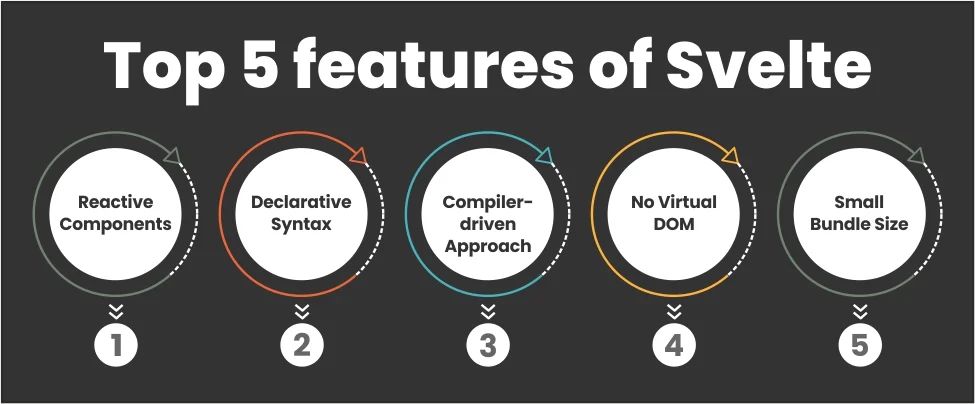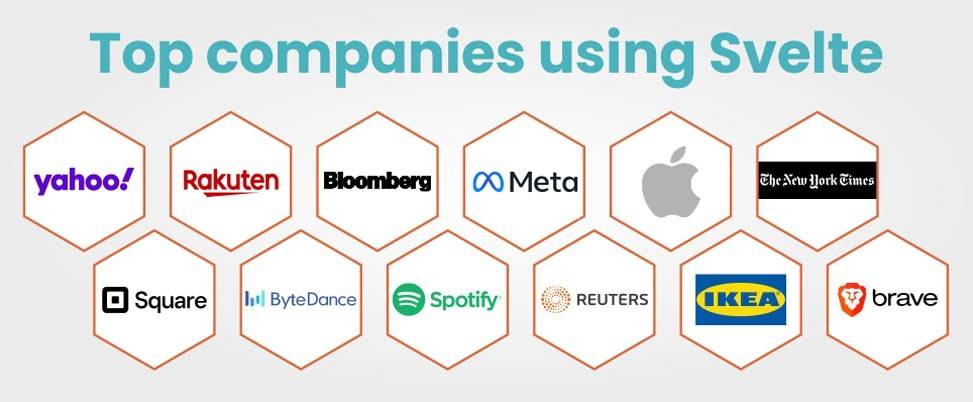Table of Contents
ToggleIntroduction
Svelte is an open-source JavaScript framework designed to build user interfaces (UIs) for web applications. Developed by Rich Harris, Svelte takes a unique approach compared to other popular front-end frameworks like React, Angular, and Vue. Instead of running in the browser, Svelte compiles components into highly efficient vanilla JavaScript during the build process. This approach shifts much of the heavy lifting from the browser runtime to the compilation step, resulting in smaller bundle sizes and faster performance.
MUST READ: SVELTE VS REACT – WHICH FRAMEWORK IS BETTER?

Don't miss out on your chance to work with the best
apply for top global job opportunities today!
What are Svelte’s key features and purposes?

- Reactive Components: With Svelte, developers can effortlessly create components that react to changes in their internal state or external data. When data changes, Svelte efficiently updates the DOM without relying on a virtual DOM. This results in enhanced performance, making it a developer friendly framework.
- Component-Based Architecture: Svelte encourages the decomposition of UIs into reusable and encapsulated components. Consequently, it improves code maintainability and reusability, a standard practice in modern frameworks.
- Smooth Animation and Transition Support: Svelte natively supports animations and transitions. It, thus, enables developers to create visually appealing and fluid user interfaces that enhance the user experience.
- Small Bundle Size: Thanks to its compilation approach, Svelte generates smaller bundle sizes for web applications. This translates to faster loading times and superior overall performance.
- Ease of Learning and Development: Svelte boasts a straightforward syntax and approach. Thus, making it accessible for developers to quickly learn and start building applications with ease.
- Framework-Agnostic Approach: Svelte can operate independently without requiring additional runtime libraries. Thus, making it adaptable to various environments and seamless integration with existing projects.
- SvelteKit: As an official extension of Svelte, SvelteKit is a comprehensive framework for developing web applications. It enriches Svelte with features like routing, server-side rendering, and more, offering a complete and advanced development experience.
Read More: Svelte vs. Flutter: Which one do you prefer?
When should you use Svelte?
Svelte is among the leading names in the JavaScript frameworks list on GitHub as per the Stack Overflow trends. Svelte is a simple framework that looks a lot like regular JavaScript code. It lets developers achieve their goals with less coding. If you want a small package size for your website, Svelte is the way to go.
Svelte is great for applications on small or low-power devices. It offers excellent control over state management, routing, and creating custom setups using its tools and frameworks. It’s perfect for tasks involving DOM manipulation, reactive frameworks, and for projects in emerging markets.
What can you build with Svelte?
Svelte is one of the best JavaScript frameworks as it can be used to build both small components and entire applications. It excels in creating fast web applications with slick interfaces. If your business aims to build such applications, Svelte could be an excellent choice.
Getting started with Svelte is straightforward. Basic knowledge of HTML, CSS, and JavaScript is enough for developers to begin building with Svelte. The framework provides user-friendly tutorials to help developers get up to speed quickly.
Considerations
Svelte is an excellent choice for developers who work independently without relying heavily on support or community.
For developers who value strong support and a large community, Svelte might not be the best option yet. However, with time, the community around the framework is likely to grow and provide more support.
Use Cases for Svelte

- Web Applications: Svelte is ideal for building web applications that require optimal performance and responsiveness. Its lightweight nature and efficient rendering make it suitable for projects of all sizes.
- Single Page Applications (SPAs): Svelte excels in creating SPAs due to its ability to handle dynamic user interfaces with ease. SPAs built with Svelte offer a smooth user experience and fast navigation.
- Prototyping: Svelte’s simplicity and rapid development capabilities make it an excellent choice for quickly prototyping ideas and concepts. Developers can swiftly build functional prototypes that can be shared and tested with stakeholders.
- Data Visualization: Svelte’s reactive data binding and smooth rendering make it a compelling choice for building data-intensive applications and visualizations.
Top companies using Svelte

Svelte is embraced by several major companies for their websites, including
- Yahoo
- Rakuten
- Bloomberg
- Meta (formerly Facebook)
- Apple
- The New York Times
- Square
- ByteDance (the parent company of TikTok)
- Spotify
- Reuters
- Ikea
- Brave, and more.
These companies choose Svelte because it compiles the application’s code into efficient JavaScript during development, ensuring that the performance of Svelte-built apps remains unaffected by framework abstractions.
Take control of your career and land your dream job
sign up with us now and start applying for the best opportunities!

Conclusion
Svelte is among the innovative JavaScript frameworks that have revolutionized the way we build web applications. With its unique compilation approach, performance optimizations, and simplicity, Svelte has quickly become a favorite among developers. Whether you’re a seasoned developer looking to boost application performance or a newcomer eager to embrace the latest technologies, Svelte is definitely worth exploring for your next front-end project. To hire Svelte developers for your team, sign up with Oliber now!
Frequently Asked Questions
Svelte compiles components during build time, resulting in smaller bundle sizes and better performance compared to traditional runtime frameworks.
No, Svelte eliminates the need for a virtual DOM, which contributes to its faster performance.
Svelte can be used to build fast web applications with slick interfaces, both as small components and as entire applications.
Developers should have a basic understanding of HTML, CSS, and JavaScript to start building with Svelte.
Yes, Svelte is useful for applications on low-capacity or low-power devices.
Svelte might have limited IDE support, depending on the Integrated Development Environment being used.
Svelte is easier to learn than React. Moreover, its code is cleaner and more intuitive. For simple websites and apps, Svelte is a good choice because it loads and renders faster, making it easier to style and create smooth-running apps.
Svelte solves the problem of reducing overhead and improving performance by compiling applications into efficient JavaScript code, resulting in faster and more streamlined DOM updates during runtime.
Yes, Svelte is a front-end JavaScript framework that allows developers to create interactive web pages and applications similar to React and Vue.
Yes, Apple is using Svelte for the web version of Apple Music, which showcases the framework’s importance and presence on a significant platform.
Absolutely, learning Svelte in 2023 is worthwhile since it is a popular and efficient JavaScript framework for building web application user interfaces, known for its speed and simplicity.
Yes, SvelteKit can be used with a backend. It has built-in features that enable developers to connect their front-end code to a backend, like a Node.js server, using common APIs and conventions.
Yes, you can build mobile apps with Svelte using Svelte Native. This allows developers to create native Android and iOS applications.

